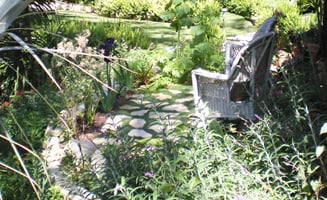

Contributor
- Topics: Archive, Inspired Gardens and Design, Sustainable
Thanks to a shifting climate, things are quickly changing in parched California. In recent years, state officials and agencies from the governor on down have been rolling out campaigns encouraging water conservation. Hopefully, homeowners won’t see raindrops and assume that the matter is resolved.

The Model Water Efficiency Landscape Ordinance (MWELO), administered by the California Department of Water Resources, was created in 1992, updated in 2009, and again in late 2015. The ordinance is specifically directed at landscaping and includes things like incorporating compost and mulch, rehabilitating compacted soil, limiting turf, and using efficient irrigation practices. By default, local water agencies and municipalities throughout the state must adopt MWELO or create a more stringent version of the ordinance and report annually on its implementation.
As landscapers (designers, architects, contractors, etc.) we have a responsibility to ensure that residential homeowners are aware of their role in dealing with ongoing challenges and their potential to be part of the solution. The California Constitution states: “the waste or unreasonable use or unreasonable method of use of water is [to be] prevented.”
As horticulturists, we need to reinforce the conservation message by understanding and implementing changes whether they are “guidelines” or “ordinances.” Rather than see this as an obstacle or annoyance, we should approach any landscape with a goal of water efficiency and whole garden health. Following MWELO and adopting a “Watershed Approach,” which incorporates soil health, plant appropriateness, and resource sensitivity as well as water use efficiency, will improve our gardens. And the numerous resulting environmental benefits could potentially earn LEED credit.
It’s time for everyone to step up and play by new landscaping rules. Appreciating the environment we live in and making realistic, responsible choices for our surroundings greatly benefits current and future stakeholders.

Welcome to MWELO
The following primer on MWELO guidelines includes links to valuable resources that will help you understand how to use this information. Spreadsheets and on-line or embedded formulas—even cell phone apps—are making it easy to calculate water needs, catchment potential, etc. The tools are out there—for free. And remember, acronyms are the language of insiders in any profession.
Does MWELO apply to me?
Yes, IF your project is:
- NEW construction with a landscape area of 500 square feet or more and if it requires a permit, plan check, or design review.
- A rehabilitated landscape project of 2,500 square feet or more.
Your local jurisdiction may have more stringent regulations. Possible exceptions include public recreational areas and cemeteries, but every locality may have different rules. Make sure to check for specifics in your area.
What do I have to do?
MWELO requires a “Landscape Documentation Package” that must be signed by a landscape architect, C-27 contractor, general contractor, landscape designer, or property owner, as well as an auditor.
This package consists of:
- Water Efficient Landscape Worksheet *
- Soil Management Plan
- Landscape Design Plan
- Irrigation Design Plan
- Grading Design Plan
- Certificate of Completion
* includes water budget calculation formulas. Visit the California Department of Water Resources website to download the latest MWELO ordinance as a PDF and click on Water Budget Calculator links to download a workbook to help you determine Maximum Applied Water Allowance (MAWA) and Estimated Total Water Use (ETWU) formulas.
What information will I need?
Most of the information you’ll need is readily available. If you know the address and size of the property, plant material, hydrozones and irrigation system details, you are in good shape; other data, like Irrigation Efficiency (IE), is included on the Water Efficient Landscape worksheet mentioned above.
How does MWELO impact what plants I select?
Plants lose water via evaporation and transpiration, or evapotranspiration (ET), depending on plant species, location, and time of year. Using weather station data, ETo is a standard reference designating the ET rate for a cool season lawn, considered the highest water user, for a specific location. A plant factor will tell you how much water that plant needs relative to the ETo; for example, the plant factor for a native plant might be 20 percent of ETo in Santa Monica in June.
MWELO requires that the water budget for a landscape equals not more than 55 percent of ETo for most residential projects. In the past these calculations have been a guessing game. But now, armed with data and algorithms, scientists can tell us how much water any plant in any area needs, at any time of the year, as a percentage of ETo. Access local ETo rates at the California Irrigation Management Information System (CIMIS) website. The Evapotranspiration Adjustment Factor (ETAF) adjusts the ETo based on plant factor and irrigation efficiency to calculate the maximum amount of water to be applied to a landscape.
Finally, refer to the Water Use Classification of Landscape Species (WUCOLS) online database for research-based plant data categorized by water use by region.
Share:
Social Media
Garden Futurist Podcast
Most Popular
Videos
Topics
Related Posts

Ground Up Science for Greener Cities with Garden Futurist Dr. Alessandro Ossola
Spring 2023 Listen to the Podcast here. Alessandro Ossola is a scientist who gets very excited about the challenge of climate change allowing for an

Readying Urban Forests for Climate Realities with Garden Futurist Dr. Greg McPherson
Winter 2023 Listen to the Podcast here. “Going from the mow and blow to a more horticulturally knowledgeable approach to maintaining the landscape. And that

Low Maintenance Gardens – Better for Pollinators and People
Autumn 2022 “I come out every day. It’s therapy, my meditation.” Janet’s young garden transformed from overgrown, invasive plants to mostly natives. The dailiness of

Invasive Plants Are Still Being Sold: Preventing Noxious Weeds in Your Landscape
Autumn 2022 With so many beautiful ornamental plant species and cultivars throughout California and the Pacific Northwest, how do you decide which ones to include










Responses